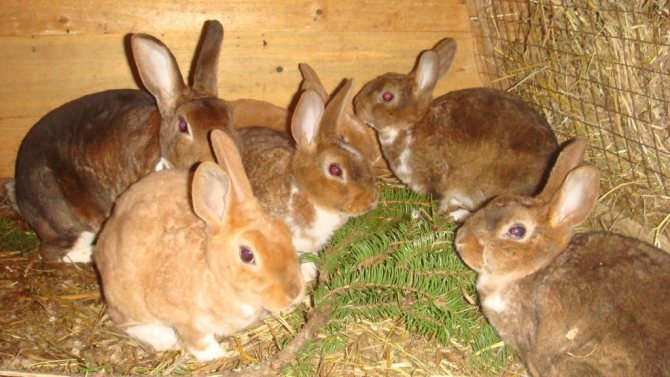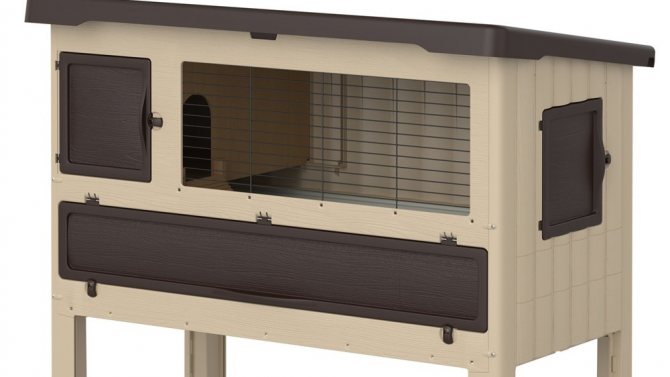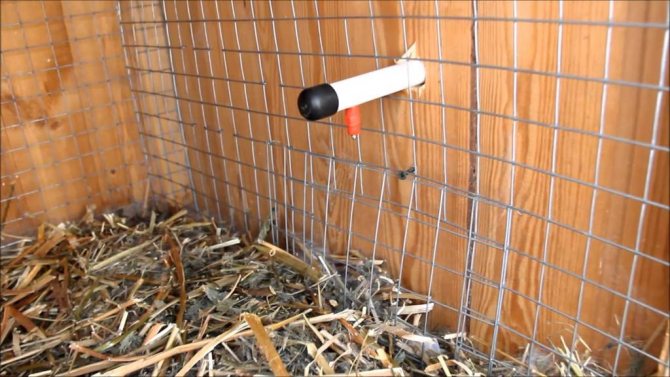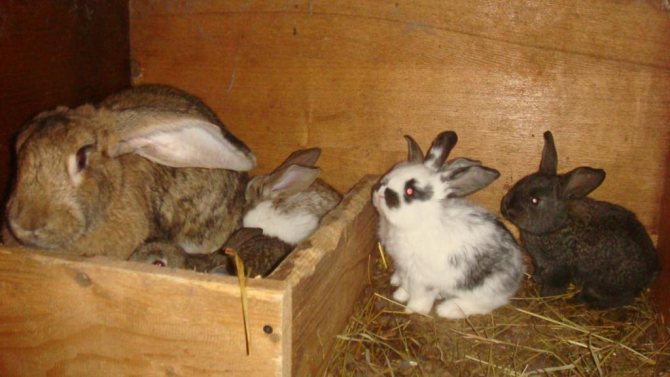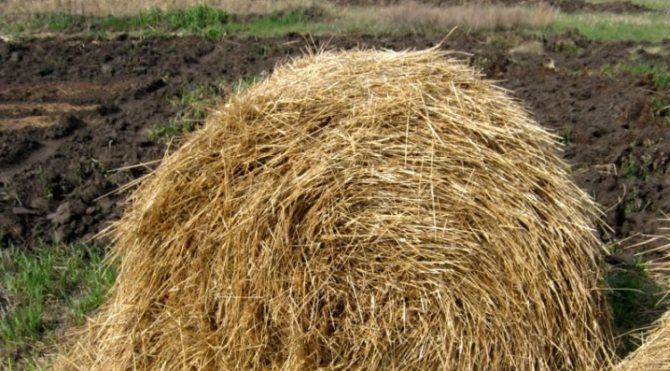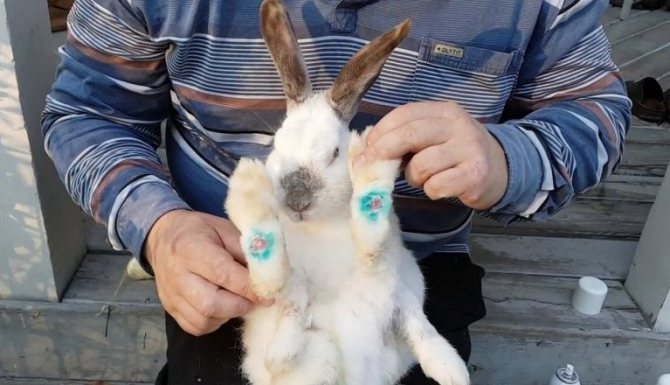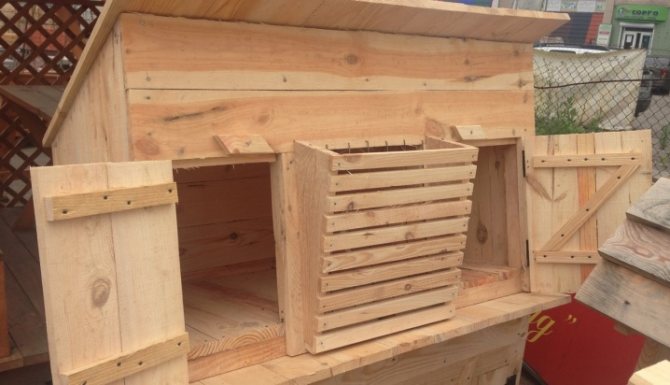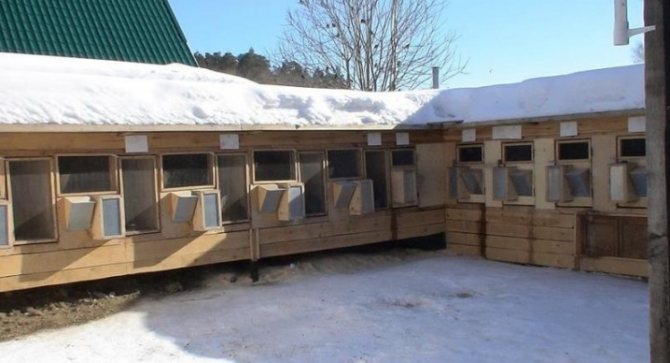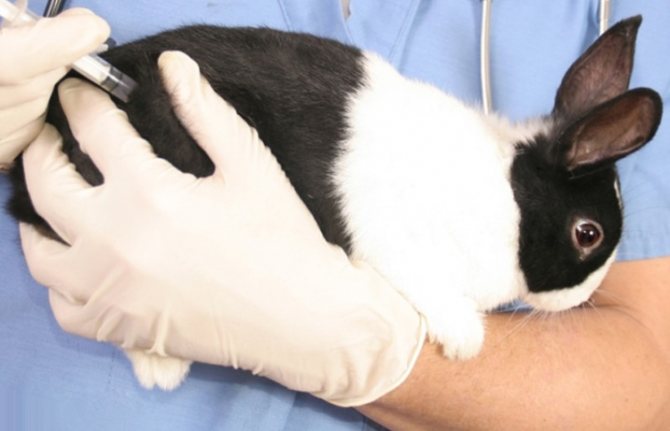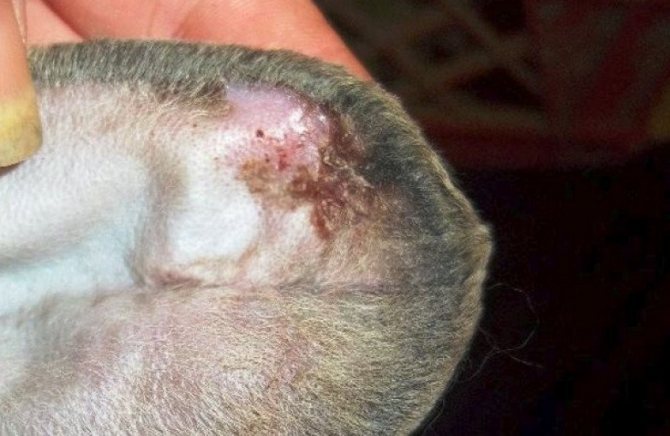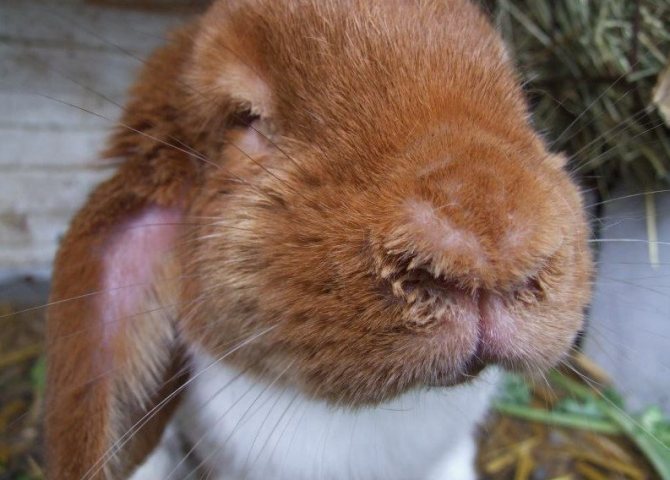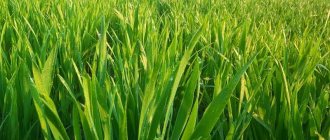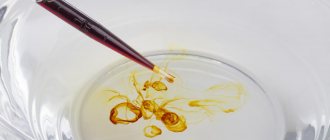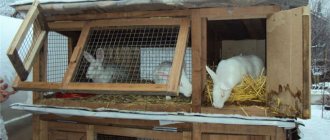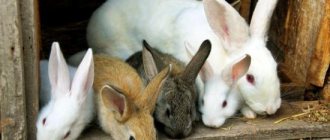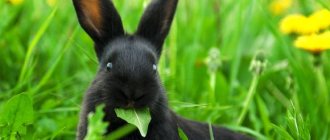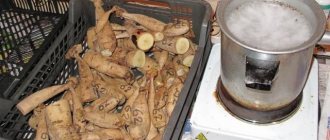Benefits
With the right approach, rabbits can be kept outdoors all year round. There are many advantages to this method.
- Cold air helps to develop stronger immunity in rabbits - such hardening is beneficial for them and strengthens the body.
- In winter, the risk of contracting infectious diseases decreases, because most bacteria die under the influence of low temperatures.
- The financial side of the issue of keeping rabbits is also important: if they live on the street for a whole year, then you will not have to spend additional funds on a separate barn.
- To equip winter cages and queen cells, you will need much less effort and money, the main thing is to be able to insulate your pets' dwelling with your own hands.
During cold weather, no gardening and field work is carried out, in which nitrogen-ammonia fertilizers are used, whose vapors very often cause the death of animals.
Rabbits in the winter on the street can even carry out a round-up and mating, but in this case, the newly-born mother and the eared offspring will need to be taken indoors.
Preparing the premises for winter
The outdoor rabbit is supposed to be kept in cages for the winter. When preparing for the cold weather, the rabbit breeder must first of all take care of the insulation of the dwelling for animals with his own hands. Winter cages for any rabbits must be insulated. For this, the space between the wall and the cage is filled with natural heat insulators as much as possible. For these purposes, dry straw, leaves of shrubs and trees, and their small branches are perfect. Additionally, foam or felt is also used, but it is important not to overdo it in order to maintain good ventilation and prevent air stagnation.
If rabbits are in cages outside in winter, care should be taken to prevent the pets from being caught in frost and dampness. One of the most effective ways to insulate a cage is to raise it by 80-85 cm more than the usual level. Special attention should be paid to the outer part of the cage. It is enough to sheathe the walls with iron, fixing it with an overlap. Such insulation will also help to avoid the accumulation of excess rainfall and maintain optimal humidity levels. Insulation of mesh floors (mesh) is usually done with a thick layer of straw. Some farmers advise covering the floor with pallets made of wooden planks. You need to choose the material that is easy to make with your own hands.
On especially cold days, it is imperative to provide additional heating from old warm clothes. Before that, they must be thoroughly shaken out before covering the cages, because the dust can harm the rabbits. There is also a wonderful little secret with which animals can heat their own home. To do this, the entire inner space of the cage should be filled with hay, and then the rabbits themselves will warm the air in one breath.
Hygiene content
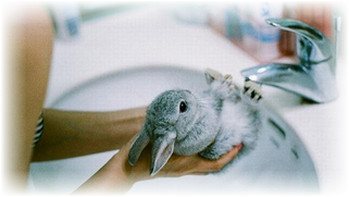
Rabbits are very sensitive to temperatures, so this factor must be monitored without fail. There is no need to try to find out additionally at what temperatures rabbits live, because they survive even in extreme conditions, if they are helped.
In summer, open rabbitries should be covered with leaves and straw to create shade.Otherwise, if the temperature of keeping rabbits exceeds 40 C and above, complications in the form of heatstroke may begin.
If, nevertheless, complications could not be avoided, then the rabbit must be urgently transferred to a cool room and sprinkled with water every 3 minutes. If you react in time, then the eared will not only survive, but will be able to return to its native cell very quickly.
Drafts and temperatures below -35 C are also harmful. To counteract, you can use special heaters, pour straw under the paws and block all approaches for drafts. If the temperature drops to -40 C, then there is a chance of frostbite, so an increase in the amount of dry straw in the cage will be very helpful.
In closed rooms, where there are good conditions for keeping rabbits, such problems cannot arise, but there are other nuances: fresh air and light. And if fresh air can be provided quite simply by forming supply and exhaust ventilation, then the light must be provided uniform.
For this, large enough windows are made that can flood the entire rabbitry with light, or a daylight system is carried out. Thanks to modern technology, such a task is no longer as expensive as in the 20th century, but you still have to spend a little money on maintenance.
Never forget about repairing cages so that rabbits do not bump into protruding wires, nails, etc. items. Even a small wound on the skin can cause severe infection, which is not immediately noticeable.
Winter feeding rabbits
Breeding farm rabbits outdoors in winter requires a special diet. The main difference between winter food is that it should be more high-calorie, because the animals spend more energy on their own heating. Rabbits eat at home with familiar foods. The main thing is that the water and food are warmed up, and the drinker and feeder are well glued. If a balanced diet is disturbed, rabbits begin to actively lose weight and become more susceptible to diseases due to weakened immunity. If you plan to breed farm rabbits in winter, you need to start watering the pets with a special vitamin solution in the fall. A video from experienced breeders will tell you how to conduct a winter round in conditions of outdoor rabbit keeping.
To increase the nutritional value of the diet, special feed additives enriched with vitamins are usually used. Also, the rate of concentrated and roughage is increased, and mash is prepared as warm food. To gain mass, decorative eared ears at home eat fodder beets, Jerusalem artichoke, carrots and boiled potatoes. In winter, it is difficult to do without auxiliary preparations and vitamin complexes, which can be purchased at pharmacies.
They are relatively inexpensive, but they allow the rabbit to survive the winter healthy. It is imperative to adhere to the established feeding regime: its frequency should be at least 5 times a day. If the required amount of food is given less frequently, the animals will not have time to eat everything, and it will simply freeze. It is important to ensure that the feed does not freeze, if this happens, it must be removed immediately.
Healthy diet
Some rabbit breeders mistakenly believe that rabbits need water to quench their thirst and in winter they stop paying due attention to watering. Water is an essential part of the basic diet as it not only helps the absorption of nutrients, but also keeps the digestive system healthy. In the absence or insufficient amount of water, rabbits can drink their urine, which negatively affects further development. In winter, due to low temperatures, the water in rabbits often freezes, and they do not have access to it, so it is important to give the animals warm water.
Various warm herbal decoctions are also considered useful, which are easily prepared from mint, lemon balm, nettle, chamomile and other herbs, which can be prepared in the summer. You need to water the rabbits at least 2 times a day and constantly monitor the purity of the water and the vessel itself.
Some give rabbits snow to quench their thirst, but it is devoid of many useful elements and can even be dangerous due to the presence of harmful substances in the atmosphere. In the summer, you can additionally prepare branch feed for animals: this will significantly help reduce the cost of winter maintenance.
In addition to nutrients, twig food is useful in that it helps to grind teeth - subsequently, cells are destroyed less. Such food is diverse, due to the different properties that individual tree species are endowed with. For example, willow and aspen feed has antimicrobial effect and helps to strengthen immunity, because once the bark of these trees was used as antibiotics. Spruce and coniferous branches are good for the possibility of harvesting both in summer and winter, and it is better to replenish stocks as needed.
Many vitamins are found in the vine, which is especially useful for lactating females and young rabbits in the phase of active growth. In the procurement process, you need to adhere to some rules. The size of the harvested branches should resemble brooms for a bath. Branch feed is dried in dark, well-ventilated places where direct sunlight does not fall. It is impossible to make the preparation in dusty rooms: because of this, rabbits often have allergies.
How to water rabbits outdoors in winter if the water freezes
In the southern regions, where the temperature does not drop to critical in winter, the pipes in the drinking bowl can be insulated with thermal insulation materials, wrapped along the entire length.
On sale in hardware stores you can purchase the following types of insulation:
- expanded polystyrene;
- fiberglass;
- heat insulating paint.
In more severe conditions, this may not be enough, heating with electricity will be required
It will be useful for you to read about what water to drink for rabbits, as well as learn how to make a drinker for rabbits with your own hands.
Electric drinker
The electrical water supply system can be purchased ready-made at the store. Many livestock breeders prefer to assemble the structure on their own, choosing the most convenient type: nipple, vacuum or main. Plus, home construction is cheaper.
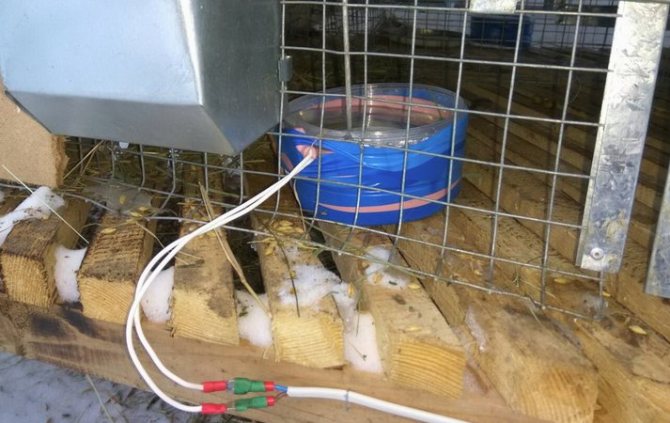

For its manufacture, in addition to the heating element, you will need hoses, fasteners, plastic or metal containers. Experienced breeders willingly share assembly instructions on the Internet.
Did you know? In 2003, in Wichita, USA, the record holder was determined, the owner of the longest rabbit ears. The ears of the rabbit were 79 cm, the corresponding entry is in the Guinness Book of Records.
Continuous topping up with warm water
This option is acceptable if you can pay attention to the animals almost around the clock. Considering that the initial freezing temperature is 0 ° C, then in severe frost the liquid freezes almost before our eyes. Therefore, besides the fact that you need to top up with warm water, you also need to make sure that the pets had time to drink it, before the icing.
Breeding
Despite all the fears, rabbits feel quite comfortable outside in winter. Some farmers practice cultivation in a greenhouse. For this, the pets are given a greenhouse for use. Inside, they create comfortable living conditions. In the greenhouse, even in frost, the optimum temperature for living is maintained. If breeding is planned in the winter in an open area, then the pets dig holes for themselves. Sometimes animals are bred in insulated cages.In such conditions, they begin to actively gain weight in order to warm themselves due to the fat layer.
True, mating and mating in them does not occur as often as in the warm season, but this does not affect the intensity of their development. Females do not tolerate pregnancy and birth in cold weather at all, since they have to spend more energy on caring for their offspring.
Okrol goes differently from the usual environment, but rabbits born in the cold season are distinguished by better health and growth, their fur is thicker and of better quality. Rabbits have better health. Such individuals will become good and productive producers in the future.
If the breeder decided to breed rabbits in winter, then some nuances should be taken into account. To do this, you need to know that there is a step-by-step instruction on how to keep rabbits in the winter. For coverage at this time, the best suited is an already mature female, who previously produced offspring: she must be able to feed the entire offspring with milk. During the winter, a healthy female can give a maximum of 2 litters, and this is worth paying attention to if rabbits are bred on an industrial scale.
Mating rabbits
The mating process itself is carried out on days when the temperature is not so low. For the mother liquor, it is necessary to prepare a more insulated cage: without this condition, newborn babies will die. A warm mother liquor is also important for the female herself: if the temperature is low, then she begins to care more about her rewarming and stops paying due attention to the little rabbits. For additional insulation, upholstery is made with foam or agrofibre to avoid wind and precipitation. For the mother liquor, it is also necessary to provide for the possibility of installing additional artificial lighting in order to extend the daylight hours.
Rabbits preparing for mating need to choose a separate diet. Moreover, the preparation is carried out about a week before the intended mating. First of all, it is necessary to increase the amount of vitamin and mineral feed. For this, special feed and feed in granules from trusted manufacturers are well suited. The rabbit is additionally given sprouted grains of cereal crops. At this time, food and water are provided for rabbits only when heated. If everything was done correctly, the female will be able to produce offspring, even if the outside temperature drops below -20 ° C.
Arrangement of the uterine department
Heated mother liquor
The health of the uterus requires special supervision.
So that the offspring does not die out, grows strong, healthy, insulated rabbitries with separate queen cells are needed.
Before throwing a male to the rabbit, you need to take care of the future of the rabbits.
The "covered" uterus should be kept in winter, in a cage, trimmed on all sides with sheets of polystyrene, with any suitable insulation.
The floors, as in the "obshchak", are covered with a dense litter, cardboard filler, perhaps, lay a boardboard on top of the net. Hygiene must be impeccable, for some reason, in the mud, the females' instinct for motherhood disappears, she ignores the cubs. The rabbits become weaker, lag behind in development, and begin to die en masse.
Kids quickly get used to pasture, they organize food with a high calorie content. Cold requires increased nutrition for the body to resist low temperatures, the ability to constantly move.
Cubs do not remain at rest for a minute, move around, try all objects on the way to the teeth. For mothers who are nursing and just expecting offspring, the food is supplemented with sprouted grains, boiled, raw vegetables.
Rabbit breeding is gaining momentum in our country, farmers appreciated the profitability of animal breeding, the great demand for final products on the market.
What to do in case of freezing of a newborn rabbit and resuscitation - you can learn from the video:
Frostbite
If mistakes were made in preparation for winter, this will certainly lead to frostbite in rabbits. First of all, this is facilitated by a poorly insulated cage, not protected from drafts. In this case, even the thick fur of the animal cannot cope with the cold, and it will get frostbite. The first symptoms by which one can determine that the animal is frozen is a change in habitual behavior. Rabbits assume unnatural postures, begin to comb the body parts with the greatest damage. At the same time, passivity and a slow, sluggish reaction are observed. The pet can refuse food or, conversely, lean on it.
At the first symptoms, the cage should be moved to a warm place to improve it and keep the temperature inside the dwelling higher. There are several stages of frostbite, in which different methods of treatment are applied. At the first stage, swelling and redness of the skin appear. Help should be provided by lubricating the affected areas with animal fat. In no case do not apply hot objects, heating pads: this will only aggravate the situation.
At the second stage of frostbite, bubbles begin to appear, which, after opening, are treated with camphor oil. At the very last, neglected stage, it is no longer possible to do without special veterinary care, since such a rabbit has wrinkling, dying off and drying out of the skin.
Of course, it is better to show the animals to a specialist at any stage of frostbite. If the rabbit breeder takes all responsibility to the preparation and organization of wintering for rabbits, then no cold is terrible for either the pets or the owner. A warm time will come - the rabbits will give a good offspring and active growth.
Useful Tips
In order for the pets to grow up outdoors in the winter and be active, you should take care of vitamin supplements. During periods of winter beriberi, it is necessary to give rabbits vitamins of all groups in small quantities. Such a measure will help animals to strengthen their immunity and add strength for growth and development. During the molting period, it is not recommended to mate animals, since the body of females already needs support.
When keeping rabbits outdoors, it is imperative to install a thermometer in the cage or greenhouse to monitor the temperature. If the breeding of animals takes place in the north of Russia, where the temperature at night can drop below -30 ° C, you need to transfer the pets to a safer room. In the greenhouse, it is necessary to close up all the holes from which cold air seeps out, and rodents - carriers of infections - can also enter from the cracks.
From time to time, even when rabbits are kept in winter, the cages, feeders and drinkers should be cleaned from contamination using disinfectants. It is better to do this when it is not very cold outside. During disinfection, animals must be removed to a safe place. After cleaning the home, the cells should be wiped dry or they will be covered with frost in the cold.
If you follow such simple rules for caring for rabbits in the winter, it will be easy to keep active and healthy animals at home or in the country.
Daily requirement of animals for liquid
The need for life-giving moisture may differ depending on the age and condition of the animal.
Important! Immediately after the release of the burden, the rabbit needs a large amount of water to replenish the moisture lost during the birth process, she can drink up to 2.5 liters. With the predominance of dry food in the diet of eared food, the liquid rate increases by about 0.5 liters.
The daily norm for various individuals of the herd is as follows:
- young animals - up to 1.5 liters;
- adult — 0.5–1 liter;
- female in position —1.5–2 liters;
- female during lactation - up to 2 liters.



